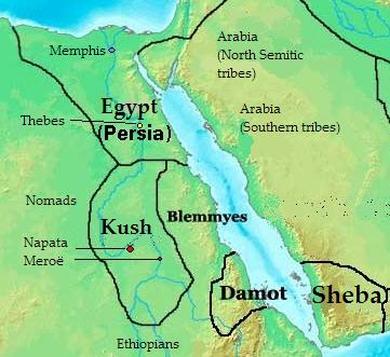Everything You Need to Know About the Kingdom of Kush
The Ancient Nubian Kingdom of Kush
Kingdom of Kush, which is also called Nubia - the Land of Gold, was located on the Nile River south of ancient Egypt. Nubia was also known as the Land of the Bow because of their expert archers. The army of archers was extremely important to the Nubian Kingdom. Many kingdoms want to control Nubia because of it's natural wealth such as iron ores, incense, ivory, and gold mines.
Brief Facts about the Ancient Kingdom of Kush
- Duration of Kingdom - 1070 BC - 350 AD
- Capital - Kerma, Napata (780 BC), and Meroe (591 BC)
- Religion - Ancient Egypt Religion
- Government - Monarchy
Trade
|
Not only did the Nile river make the Kingdom flourish in agriculture, but it was used as a major trade route. This river along with the Red sea made the Kingdom of Kush a very accessible location. It was a meeting point of traders coming from Egypt, Europe, and the Mediterranean. The Kushites traded Gold, Ivory, Ebony, Ostrich eggs, Feathers, various animals, and also slaves. This area was known as the Iron Capital of Ancient Africa. The Egyptians in return offered papyrus sheets, wheat, barley, and gold.
|
Social Structure and Political Authority
|
The Kushites lived in tribes also known as chiefdoms. In general, work was divided equally among all people (other than slaves). Equality was very important in these tribes and all people were treated equally. However, every tribe needs some sort of hierarchy. In the Kingdom of Kush, the elders were given slightly more power. At the head of the tribe was a chief. people could become the chief by being the strongest, wisest, or most religious. Although chiefs and elders were more respected, and given more power, they still participated in the tribe.
|
Female Rulers
|
The Candances of Meroe were the queens of the Kingdom of Kush who ruled from the city of Meroe 284 BCE - 314 CE - a number of whom ruled independently 170 BCE - 314 CE - in what is now Sudan. The title Candace is the Latinized version of the term Kentake or Kandake in Meroitic and may mean “Queen Regent” or “Queen Mother” but could also mean “Royal Woman”. Although the term seems to have originally referred to the mother of the king, from around 170 BCE it was also used to designate a female monarch who reigned independently. For more information on this fascinating subject, please click the button below.
|
Maps of the Nubian Kingdom
Major Events in the Nubian Kingdom
- 1070 BC: After 500 years of Egyptian rule, the Nubian Kingdom gains independence
- 750 BC: King Piye invades and conquers Egypt This creates the 25th dynasty of Egypt. The city of Napata becomes the capital of the expanded kingdom of Kush.
- 673 BC: The Assyrians invade and force the Kushites out of Egyptian territory. Kush returns to its original borders, with its capital as the city of Meroe.
- 664 BC: King Tantamani of Kush gathers a large army and retakes Egypt. it only lasts 8 years, and the Assyrians forced the Kushites out of Egypt again.
- AD 352:Kush is taken over by Axum
Rise and Fall of the Kingdom of Kush

Around 1500 B.C., Egyptian leaders sent armies in to overpower Kush. they controlled the Kusites for about 500 years. the tables turned when the Kushites attacked Egypt and gained independence. In 724 B.C., the Kushite king, Piankhi, sent a Kushite army to invade Egypt and control it. In 671 B.C., the Assyrians were able to run the Kushites out of Egypt and gain rule of of it for themselves. The Assyrians used iron weapons to defeat the Kushite's bronze weapons. After returning to their original borders, the Kingdom of Kush entered a golden age and bceame wealthy over a period of 150 years. This was brought to an end by the axums people invading.
Interesting Facts About the Kingdom of Kush
- In battle, Kush was famous for its archers and the bow and arrow were often depicted in the art of Ancient Kush. Sometimes the region was called the "Land of the Bow" because of its famous archers.
- One of the most famous leaders of Kush was Piye who conquered Egypt and became pharaoh of Egypt.
- Most of the people of Kush were farmers. Their primary crops were wheat and barley. They also grew cotton to make clothing.
- The pyramids of Kush tended to be smaller than the pyramids of Egypt. The burial chambers were located below the pyramids. Many of these pyramids were built near the city of Meroe and can still be seen today.
- The priests were so powerful they could decide when it was time for the king to die.
- People didn't live very long in Kush. The average person was expected to live only 20 to 25 years.
- Besides gold and iron, other important trade items included ivory, slaves, incense, feathers, and wild animal hides.
YouTube Playlist on the Kush Empire
History Podcasts: Listen to Kingdom of Kush Lessons
This Site...
This site is a concerted effort. It is maintained with the cooperation and collaboration of many colleagues, professors and the invaluable advice of students. This site is intended to spread experience, and share educational materials, resources, and ideas. This site and anything found on it is intended for educational purposes and not for profit.
Disclaimer...
This page identifies resources and links to others that would be useful to students and teachers. The opinions expressed on these pages are solely those of the host website and not those of any one particular school or district.










